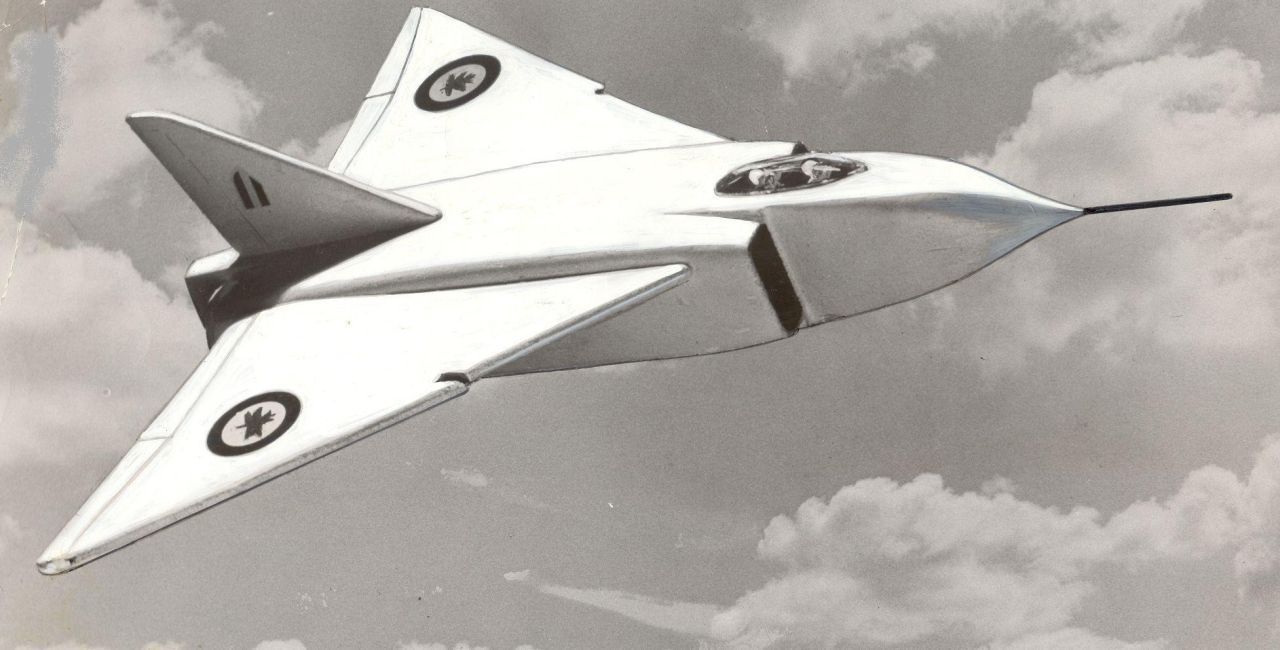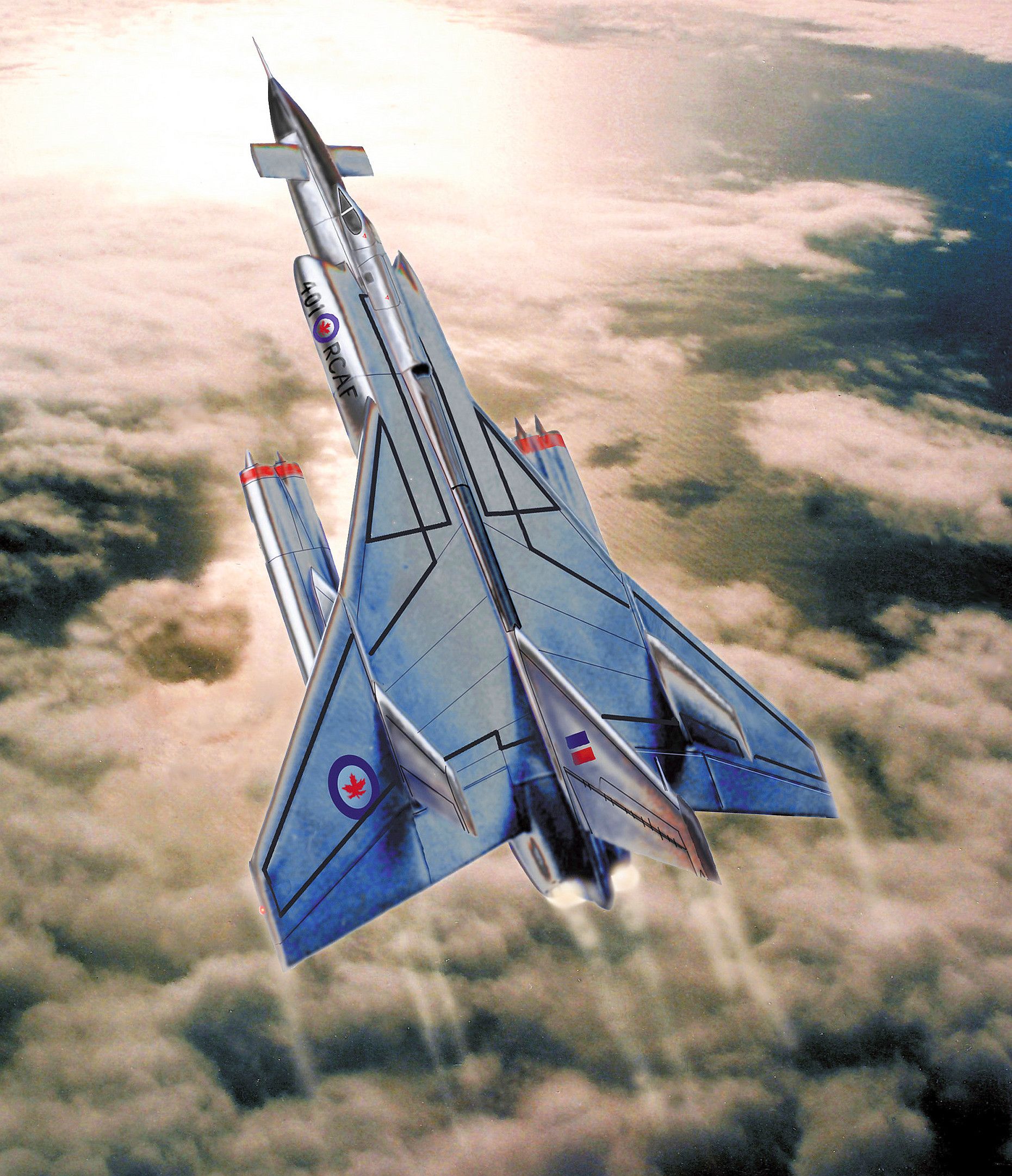THE WAY WE WERE: What might have been for our Avro Arrow
Mike Filey
Published:
February 23, 2019
Updated:
February 23, 2019 12:00 PM EST
Avro Canada's new supersonic interceptor/fighter was still more than a week away from being unveiled to the general public when the Toronto Telegram newspaper edition dated Sept. 26, 1957 featured this staff artist's concept of what the new aircraft "might" look like. Delta-wing, yes; two-seater, yes; the rest was sort of close.
It was exactly 60 years ago last Wednesday — Feb. 20, 1959, to be precise – that something happened in the evolution of aviation here in Canada resulting in that date forever being described “Black Friday.”
On that day, the Federal government put an end to a project that was underway at Avro Canada’s aircraft manufacturing facility northwest of Toronto which, if allowed to proceed, would have seen the creation not only of a much-needed replacement for the RCAF’s aging CF-100 jet fighter/interceptor, but a plane that would have revolutionized the future development of military aircraft worldwide.
Over the intervening six decades pretty well everything for and against the continued development of the Avro Arrow has been documented in word, on film and more recently all over the internet.
In fact, a Google search of “Avro Arrow” presents more than 2.8 million hits.
THE WAY WE WERE: Up, up and away
Cancelling Avro Arrow a costly nightmare
Time to step up to save Avro Arrow replica
Not to miss out on recording something in recognition of the 60th anniversary of the Arrow’s demise, I decided for this column I would feature just a few of the lesser known Arrow-related stories.
Story continues below
Nearly four months before the public got its first look at the new Avro Arrow, International Business Machines Co. Ltd., located on Don Mills Rd., ran this advertisement in the local papers stating proudly that Avro had installed one of the company’s $2 million Model 704 “scientific computers,” the first of its kind in Canada, that would save the company “thousands of hours on supersonic aircraft development.”
In chasing down more details about the company’s choice of the IBM 704 to assist in the development of the Arrow, Google led me to a website created by Lee Jennings (zl2al.com), a former Torontonian who had moved to New Zealand. This image is from Mr. Jennings’ site and shows him at the console of Avro’s massive 13,600 kilogram IBM 704 computer. Unfortunately, I’ve been unable to contact Lee to get some of his memories from the time when he was with the Avro company. For instance, was the computer purchased or was it leased? How would it compare with today’s laptops or my PC?
Like many people, I wondered what might have happened had the Arrow project been nurtured by those in charge instead of terminated with the resulting job losses not just at Avro Canada but across the country. More internet searching led me to another website, this one featuring the late Randall Whitcomb’s book Cold War Tech War, the Politics of America’s Air Defense, which can be purchased online at cgpublishing.com. It’s listed as #27C. In Randall’s book he features several of his paintings depicting his ideas of how the original Arrows might have evolved. While this Canadian aviation story has both proponents and opponents one thing is for sure, the arguments pro and con will still be voiced, verbally and digitally, for years to come. (Randall Whitcomb/Apogeebooks.com).
See you at the annual Toronto Postcard Club Show on Sunday.
mfiley@sunmedia.com




http://torontosun.com/news/local-news/the-way-we-were-what-might-have-been-for-our-avro-arrow
Mike Filey
Published:
February 23, 2019
Updated:
February 23, 2019 12:00 PM EST
Avro Canada's new supersonic interceptor/fighter was still more than a week away from being unveiled to the general public when the Toronto Telegram newspaper edition dated Sept. 26, 1957 featured this staff artist's concept of what the new aircraft "might" look like. Delta-wing, yes; two-seater, yes; the rest was sort of close.
It was exactly 60 years ago last Wednesday — Feb. 20, 1959, to be precise – that something happened in the evolution of aviation here in Canada resulting in that date forever being described “Black Friday.”
On that day, the Federal government put an end to a project that was underway at Avro Canada’s aircraft manufacturing facility northwest of Toronto which, if allowed to proceed, would have seen the creation not only of a much-needed replacement for the RCAF’s aging CF-100 jet fighter/interceptor, but a plane that would have revolutionized the future development of military aircraft worldwide.
Over the intervening six decades pretty well everything for and against the continued development of the Avro Arrow has been documented in word, on film and more recently all over the internet.
In fact, a Google search of “Avro Arrow” presents more than 2.8 million hits.
THE WAY WE WERE: Up, up and away
Cancelling Avro Arrow a costly nightmare
Time to step up to save Avro Arrow replica
Not to miss out on recording something in recognition of the 60th anniversary of the Arrow’s demise, I decided for this column I would feature just a few of the lesser known Arrow-related stories.
Story continues below
Nearly four months before the public got its first look at the new Avro Arrow, International Business Machines Co. Ltd., located on Don Mills Rd., ran this advertisement in the local papers stating proudly that Avro had installed one of the company’s $2 million Model 704 “scientific computers,” the first of its kind in Canada, that would save the company “thousands of hours on supersonic aircraft development.”
In chasing down more details about the company’s choice of the IBM 704 to assist in the development of the Arrow, Google led me to a website created by Lee Jennings (zl2al.com), a former Torontonian who had moved to New Zealand. This image is from Mr. Jennings’ site and shows him at the console of Avro’s massive 13,600 kilogram IBM 704 computer. Unfortunately, I’ve been unable to contact Lee to get some of his memories from the time when he was with the Avro company. For instance, was the computer purchased or was it leased? How would it compare with today’s laptops or my PC?
Like many people, I wondered what might have happened had the Arrow project been nurtured by those in charge instead of terminated with the resulting job losses not just at Avro Canada but across the country. More internet searching led me to another website, this one featuring the late Randall Whitcomb’s book Cold War Tech War, the Politics of America’s Air Defense, which can be purchased online at cgpublishing.com. It’s listed as #27C. In Randall’s book he features several of his paintings depicting his ideas of how the original Arrows might have evolved. While this Canadian aviation story has both proponents and opponents one thing is for sure, the arguments pro and con will still be voiced, verbally and digitally, for years to come. (Randall Whitcomb/Apogeebooks.com).
See you at the annual Toronto Postcard Club Show on Sunday.
mfiley@sunmedia.com




http://torontosun.com/news/local-news/the-way-we-were-what-might-have-been-for-our-avro-arrow